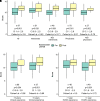Development of a Standardized Assessment of Simulation-based Extracorporeal Membrane Oxygenation Educational Courses
- PMID: 35924196
- PMCID: PMC9341478
- DOI: 10.34197/ats-scholar.2021-0068OC
Development of a Standardized Assessment of Simulation-based Extracorporeal Membrane Oxygenation Educational Courses
Abstract
Background: In 2020, the Extracorporeal Life Support Organization education task force identified seven extracorporeal membrane oxygenation (ECMO) educational domains that would benefit from international collaborative efforts. These included research efforts to delineate the impact and outcomes of ECMO courses.
Objective: Development of a standardized online assessment tool to evaluate the effectiveness of didactic and simulation-based ECMO courses on participants' confidence, knowledge, and simulation-based skills; participant satisfaction; and course educational benefits.
Methods: We performed a prospective multicenter observational study of five different U.S. academic institution-based adult ECMO courses that met Extracorporeal Life Support Organization endorsement requirements for course structure, educational content, and objectives. Standardized online forms were developed and administered before and after courses, assessing demographics, self-assessment regarding ECMO management, and knowledge examination (15 simple-recall multiple-choice questions). Psychomotor skill assessment was performed during the course (time to complete prespecified critical actions during simulation scenarios). Self-assessment evaluated cognitive, behavioral, and technical aspects of ECMO; course satisfaction; and educational benefits.
Results: Out of 211 participants, 107 completed both pre- and postcourse self-assessment forms (97 completed both pre- and postcourse knowledge forms). Fifty-three percent of respondents were physician intensivists, with most (51%) practicing at academic hospitals and with less than 1 year of ECMO experience (50%). After the course, participants reported significant increases in confidence across all domains (cognitive, technical, and behavioral, P < 0.0001, 95% confidence interval [CI], 1.2-1.5; P < 0.0001, 95% CI, 2.2-2.6; and P = 0.002, 95% CI, 1.7-2.1, respectively) with an increase in knowledge scores (P < 0.001; 95% CI, 1.4-2.5). These findings were most significant in participants with less ECMO experience. There were also significant reductions in times to critical actions in three of the four scored simulation scenarios. The results demonstrated participants' satisfaction with most course aspects, with more than 95% expressing that courses met their educational goals.
Conclusion: We developed and tested a structured ECMO course assessment tool, demonstrating participants' self-reported benefit as well as improvement in psychomotor skill acquisition, course satisfaction, and educational benefits. Course evaluation is feasible and potentially provides important information to improve ECMO courses. Future steps could include national implementation, addition of questions targeting clinical decision making to further assess knowledge gain, and multilanguage translation for implementation in international courses.
Keywords: Extracorporeal Life Support Organization education task force; course assessment; education; extracorporeal membrane oxygenation; simulation.
Copyright © 2022 by the American Thoracic Society.
Figures



References
-
- Bartlett RH. Esperanza: the first neonatal ECMO patient. ASAIO J . 2017;63:832–843. - PubMed
-
- Extracorporeal Life Support Organization (ELSO) ECLS registry report: international summary. Ann Arbor, MI: ELSO; 2020.
-
- Australia and New Zealand Extracorporeal Membrane Oxygenation (ANZ ECMO) Influenza Investigators. Extracorporeal membrane oxygenation for 2009 influenza A(H1N1) acute respiratory distress syndrome. JAMA . 2009;302:1888–1895. - PubMed
-
- Pham T, Combes A, Rozé H, Chevret S, Mercat A, Roch A, et al. REVA Research Network Extracorporeal membrane oxygenation for pandemic influenza A(H1N1)-induced acute respiratory distress syndrome: a cohort study and propensity-matched analysis. Am J Respir Crit Care Med . 2013;187:276–285. - PubMed
-
- Peek GJ, Mugford M, Tiruvoipati R, Wilson A, Allen E, Thalanany MM, et al. CESAR trial collaboration Efficacy and economic assessment of conventional ventilatory support versus extracorporeal membrane oxygenation for severe adult respiratory failure (CESAR): a multicentre randomised controlled trial. Lancet . 2009;374:1351–1363. - PubMed
LinkOut - more resources
Full Text Sources
Miscellaneous

